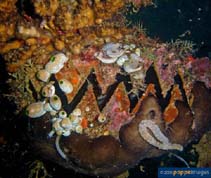Hyotissa hyotis (Linnaeus, 1758)
Honeycomb oyster| Native range | All suitable habitat | Point map | Year 2050 |

|
| This map was computer-generated and has not yet been reviewed. |
| Hyotissa hyotis AquaMaps Data sources: GBIF OBIS |
Classification / Names Common names | Synonyms | CoL | ITIS | WoRMS
| Ostreida | Gryphaeidae
Environment: milieu / climate zone / depth range / distribution range Ecologia
; intervalo de profundidade 0 - 50 m (Ref. 348), usually 0 - 5 m (Ref. 348). Tropical
Distribuição Países | Áreas FAO | Ecossistemas | Ocorrências | Introduções
Indo-Pacific and Western Central Atlantic: from East Africa, to eastern Polynesia; north to Japan and south to Western Australia and Queensland.
Length at first maturity / Tamanho / Peso / Idade
Maturity: Lm ? range ? - ? cm Max length : 30.0 cm SHH macho/indeterminado; (Ref. 348); common length : 18.0 cm SHH macho/indeterminado; (Ref. 348)
Epibiotic (Ref. 104365). Found in reef areas of lagoons (Ref. 97298). Cemented to hard substrates. Mostly in intertidal and shallow subtidal levels to a depth of 5 m, but also to a depth of 50 m (Ref. 348).
Life cycle and mating behavior Maturidade | Reprodução | Desova | Ovos | Fecundidade | Larvas
Members of the class Bivalvia are mostly gonochoric, some are protandric hermaphrodites. Life cycle: Embryos develop into free-swimming trocophore larvae, succeeded by the bivalve veliger, resembling a miniature clam.
Referência principal
Referências | Coordenador | Colaboradores
Poutiers, J.M. 1998. (Ref. 348)
Categoria na Lista Vermelha da IUCN (Ref. 130435)
Categoria CITES (Ref. 108899)
Not Evaluated
CMS (Ref. 116361)
Not Evaluated
Ameaça para o homem
Harmless
Utilização humana
Pescarias: espécies comerciais
| FishSource |
Ferramentas
Mais informação
Idade/Tamanho
Crescimento
Comprimento-peso
Comprimento-comprimento
Morfologia
Larvas
Abundância
Crescimento
Comprimento-peso
Comprimento-comprimento
Morfologia
Larvas
Abundância
Fontes da internet
BHL | BOLD Systems | CISTI | DiscoverLife | FAO(Publication : search) | Fishipedia | GenBank (genoma, nucleotídeo) | GloBI | Gomexsi | Google Books | Google Scholar | Google | PubMed | Árvore da vida | Wikipedia (ir para, procurar) | Registo zoológico
Estimates based on models
Preferred temperature
(Ref. 115969): 23.3 - 29.2, mean 27.9 (based on 4710 cells).
Categoria de preço
(Ref. 80766):
Unknown.



